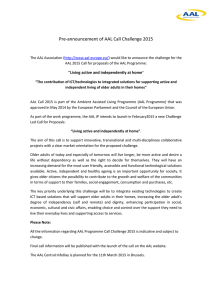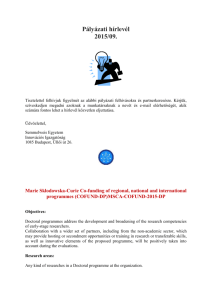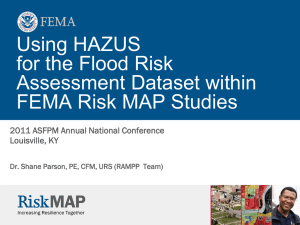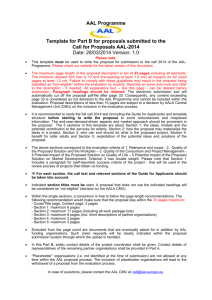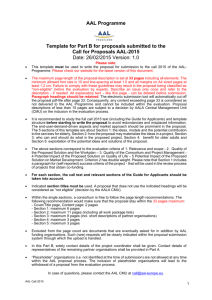Hazus AAL Study
advertisement
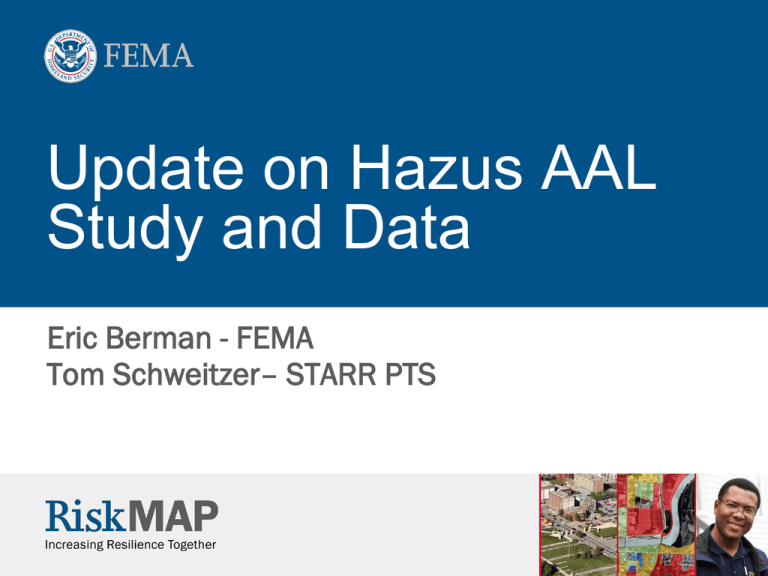
Update on Hazus AAL Study and Data Eric Berman - FEMA Tom Schweitzer– STARR PTS Contributors Tom Schweitzer PTS – STARR Dan Deegan PTS – BakerAECOM Shane Parson PTS – RAMPP 2 Past Flood Risk Assessments: Pre-HAZUS Studies Donnelly Data – mid 1980’s: • Ranking of communities • Use for decisions on mapping restudies Property At Risk Data: • Refinement of Donnelly • Removed areas that would not be developed (water bodies) 3 Average Annualized Loss (AAL) FEMA initiated the AAL Study in 2009 to provide a Nationwide Loss Dataset Level 1 conducted on every county in the contiguous United States using Hazus-MH for both Riverine and Coastal analysis Used national data sets for consistency within the analysis Losses based on building and contents 4 Summary of Average Annualized Loss (AAL) Study Hazus AAL Study • Completed March 2010 • Used Hazus-MH MR4 • Losses for 48 states and the District of Columbia • Included 3,109 counties • Calculated losses for five return periods: 10-year / 50-year / 100-year / 200-year / 500-year • Calculated average annualized losses (AAL) • AAL losses extracted from HPR files at the Census block • AAL losses complied by county, state, and watershed (HUC-8, April 2010 WBD) • Usability analysis performed 5 Summary of AAL Study 2009-10 Hazus-MH Flood Average Annualized Loss Estimation (AAL) was performed for continental U.S. Level 1 Analysis Inputs: • County-wide regions • 10 sq mile drainage area • 30M USGS DEM • Default Census data (GBS) Final Output included: • Return period losses • Total exposure • Average Annualized Loss • Annualized Loss Ratio Relative Average Annualized Losses by State 6 AAL Results Total Annualized Losses Estimated at 55 Billion: • Includes both riverine and coastal Annualized Loss Ratio by State Relative Average Annualized Losses by State Using NFIP program average annual losses and other source of annual flood loss data, sets a lower bound of the annualized flood loss at minimum of 10 billion annually. 7 Hazus AAL Usability Analysis Hazus AAL Usability Analysis (Performed by the 3 FEMA PTS) • Completed 4/2011 • Analyzed several aspects of Hazus flood loss hazard development and calculation and understand constraints • Analyzed Hazus procedures to see if there are factors that contributed to the high initial AAL loss number • Can any of the procedures be quantified and used to adjust the AAL loss totals? • Developed an understanding of the limitations of a level 1 Hazus analysis (10 sqmi) • Is the AAL data a usable data set for Risk MAP? 8 Hazus AAL Usability Analysis SUMMARY • Use of 30 M DEM - some issues in developing an accurate flood hazard, (only national topography data set) • Use of the Census data is appropriate for this level of analysis (planning level) • The weighted area method for losses can overstate losses • 10 sqmi drainage area - though limiting, use of smaller threshold requires significantly more resources (processing time) • Possible double counting of losses in coastal areas 9 Hazus AAL Usability Analysis SUMMARY • AAL losses were overstated with 2 and 5 year return periods losses included in the AAL calculation (removed from final AAL estimate) • AAL losses were recalculated outside of Hazus using the 5 return periods (10, 50, 100, 200, 500-year) losses • AAL losses were calculated using Log normal* • Should use only one cross-section for all return periods • Data is appropriate for use in Discovery meetings, sequencing and general comparison of relative risk between areas * Hazus 2.1 uses a linear AAL calculation 10 Average Annualized Loss Availability Data & Format • Shapefile format • Access Database • Data available by census block (2000 Census) • Data available by watershed (HUC) 11 GIS Format Intended Uses: • Identify flood prone areas and • Communicate relative flood risk (building and content losses) 12 Use of AAL Values Loss values need to be shown as relative rather than absolute dollar amounts. 13 Discovery Meeting Discovery Map 14 Current AAL Data Availability Annualized Losses by Census Block (2000 Census) 1. Availability Data & Format Can be used to satisfy Discovery meeting requirements 15 Flood Risk Assessment Purpose and Intended Uses Identify Areas and Communicate Relative Flood Risk: • Flood prone areas • Vulnerable people and property Provide Flood Risk $: • Potential damage severity for different flood frequencies • Identify locations with possible cost effective mitigation options Improve Estimates for Flood Risk $: • Losses from Average Annualized Loss (AAL) Study • Refined losses from new flood study depth grids • Refined general building stock data from local sources 16 AAL Data Requirements – Appendix O Appendix O for Risk MAP Requires other data from the Hazus AAL data set 17 AAL Data Requirements – Appendix O AAL Access table only provides annualize loss data for: • Total Loss • Building Loss – Total • Contents Loss – Total L_RA_AAL requires the following to be extracted from AAL Study.HPR (Hazus) files: • Data for all 5 individual return periods • More detailed loss data fields (such as total, building, and contents losses divided into residential, commercial, and other) 18 Flood Risk Data AAL data has been compiled into a single database for use in extracting the required data in Appendix O format We have develop a tool that performs this extraction into MS Access Databases This is the initial assessment data that is required to populate the Risk Database for use in producing Risk MAP non-regulatory products 19 Flood Risk Data Currently we are finalizing the data. It can be requested from the PTS contractor for your Region. 20 Flood Risk Assessment Delivered 21 Flood Risk Map Elements 22 Flood Risk Report Elements 23 Moving Forward The process for compiling the new data into a national data sets has not yet been determined Additionally the process to stored and distributed this data nationally as yet been determined Currently we are looking at storing the data associated with Flood Risk Databases in the MIP until other means can be developed to house the information. 24
